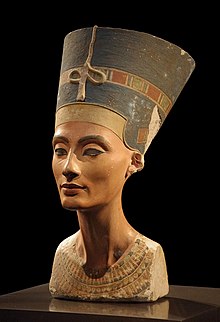
Back Nefertiti Afrikaans Nofretete ALS نفرتيتي Arabic نفرتيتى ARZ Nefertiti AST Nefertiti Azerbaijani نفرتیتی AZB Нефертити Bashkir Nefertiti BCL Неферціці Byelorussian
| Nefertiti | |||||
|---|---|---|---|---|---|
 | |||||
| Queen consort of Egypt | |||||
| Tenure | 1353–1336 BC[1] or 1351–1334 BC[2] | ||||
| Pharaoh | |||||
| Reign | c. 1334–1332 BC | ||||
| Predecessor | Smenkhkare | ||||
| Successor | Tutankhamun | ||||
| Born | c. 1370 BC Thebes, Egypt | ||||
| Died | c. 1330 BC | ||||
| Spouse | Akhenaten | ||||
| Issue | |||||
| |||||
| Dynasty | 18th of Egypt | ||||
| Father | Ay (possibly) | ||||
| Mother | Iuy (possibly) | ||||
| Religion | Atenism | ||||
| Neferneferuaten-Nefertiti in hieroglyphs | ||||||||||||||
|---|---|---|---|---|---|---|---|---|---|---|---|---|---|---|
Neferneferuaten Nefertiti Nfr nfrw itn Nfr.t jy.tj Beautiful are the Beauties of Aten, the Beautiful one has come | ||||||||||||||
Nefertiti (/ˌnɛfərˈtiːti/[3]) (c. 1370 – c. 1330 BC) was a queen of the 18th Dynasty of Ancient Egypt, the great royal wife of Pharaoh Akhenaten. Nefertiti and her husband were known for their radical overhaul of state religious policy, in which they promoted the earliest known form of monotheism, Atenism, centered on the sun disc and its direct connection to the royal household. With her husband, she reigned at what was arguably the wealthiest period of ancient Egyptian history.[4] After her husband's death, some scholars believe that Nefertiti ruled briefly as the female king known by the throne name, Neferneferuaten and before the ascension of Tutankhamun, although this identification is a matter of ongoing debate.[5][6] If Nefertiti did rule as Pharaoh, her reign was marked by the fall of Amarna and relocation of the capital back to the traditional city of Thebes.[7]
In the 20th century, Nefertiti was made famous by the discovery and display of her ancient bust, now in Berlin's Neues Museum. The bust is one of the most copied works of the art of ancient Egypt. It is attributed to the Egyptian sculptor Thutmose, and was excavated from his buried studio complex in the early 20th century.
- ^ "Akhenaton". Encyclopædia Britannica. Archived from the original on 26 May 2007.
- ^ von Beckerath, Jürgen (1997). Chronologie des Pharaonischen Ägypten. Mainz: Philipp von Zabern. p. 190.
- ^ "Nefertit". Collins Dictionary. n.d. Archived from the original on 23 September 2015. Retrieved 24 September 2014.
- ^ Freed, R. E.; D'Auria, S.; Markowitz, Y. J. (1999). Pharaohs of the Sun: Akhenaten, Nefertiti, Tutankhamen. Leiden: Museum of Fine Arts.
- ^ Dodson, Aidan (2009). Amarna Sunset: Nefertiti, Tutankhamun, Ay, Horemheb, and the Egyptian Counter-Reformation (PDF). The American University in Cairo Press. pp. 36–38. ISBN 978-977-416-304-3.
- ^ Van de Perre, Athena (2014). "The Year 16 graffito of Akhenaten in Dayr Abū Ḥinnis: A contribution to the study of the later years of Nefertiti". Journal of Egyptian History. 7: 67–108. doi:10.1163/18741665-12340014.
- ^ Badger Utopia (11 August 2017). Nefertiti - Mummy Queen of Mystery. Archived from the original on 1 April 2022. Retrieved 30 October 2017 – via YouTube.
© MMXXIII Rich X Search. We shall prevail. All rights reserved. Rich X Search